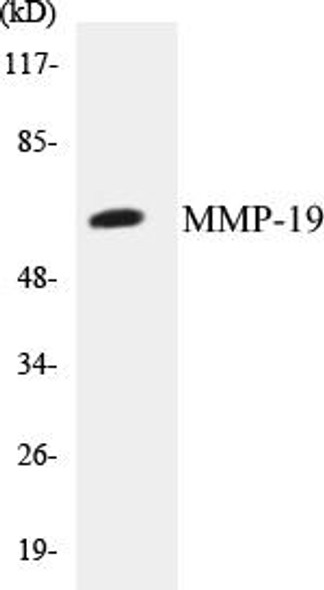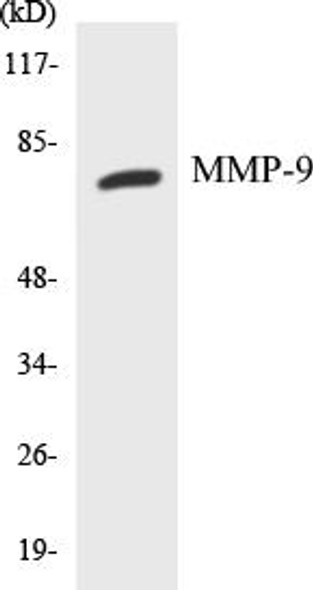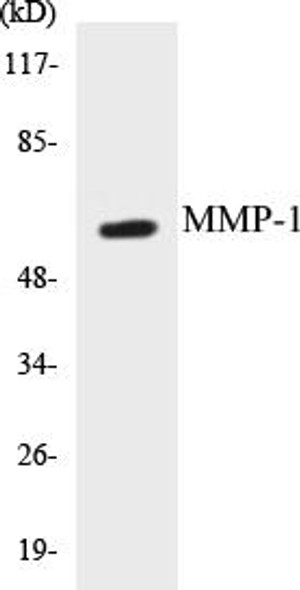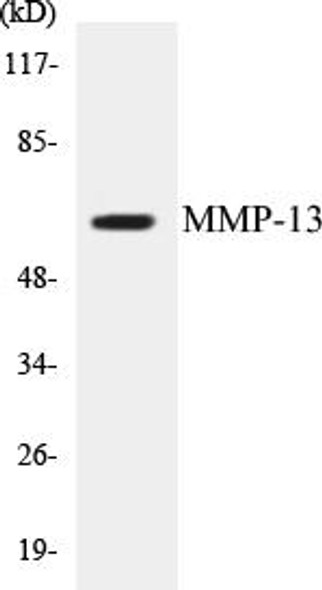Cell Biology
MMP-3 Colorimetric Cell-Based ELISA Kit
- SKU:
- CBCAB00766
- Product Type:
- ELISA Kit
- ELISA Type:
- Cell Based
- Research Area:
- Cell Biology
- Reactivity:
- Human
- Reactivity:
- Mouse
- Reactivity:
- Rat
- Detection Method:
- Colorimetric
Description
| Product Name: | MMP-3 Colorimetric Cell-Based ELISA |
| Product Code: | CBCAB00766 |
| ELISA Type: | Cell-Based |
| Target: | MMP-3 |
| Reactivity: | Human, Mouse, Rat |
| Dynamic Range: | > 5000 Cells |
| Detection Method: | Colorimetric 450 nmStorage/Stability:4°C/6 Months |
| Format: | 96-Well Microplate |
The MMP-3 Colorimetric Cell-Based ELISA Kit is a convenient, lysate-free, high throughput and sensitive assay kit that can detect MMP-3 protein expression profile in cells. The kit can be used for measuring the relative amounts of MMP-3 in cultured cells as well as screening for the effects that various treatments, inhibitors (ie siRNA or chemicals), or activators have on MMP-3.
Qualitative determination of MMP-3 concentration is achieved by an indirect ELISA format. In essence, MMP-3 is captured by MMP-3-specific primary antibodies while the HRP-conjugated secondary antibodies bind the Fc region of the primary antibody. Through this binding, the HRP enzyme conjugated to the secondary antibody can catalyze a colorimetric reaction upon substrate addition. Due to the qualitative nature of the Cell-Based ELISA, multiple normalization methods are needed:
| 1. | A monoclonal antibody specific for human GAPDH is included to serve as an internal positive control in normalizing the target absorbance values. |
| 2. | Following the colorimetric measurement of HRP activity via substrate addition, the Crystal Violet whole-cell staining method may be used to determine cell density. After staining, the results can be analysed by normalizing the absorbance values to cell amounts, by which the plating difference can be adjusted. |
| Database Information: | Gene ID: 4314, UniProt ID: P08254, OMIM: 185250, Unigene: Hs.375129 |
| Gene Symbol: | MMP3 |
| Sub Type: | None |
| UniProt Protein Function: | MMP3: Can degrade fibronectin, laminin, gelatins of type I, III, IV, and V; collagens III, IV, X, and IX, and cartilage proteoglycans. Activates procollagenase. Defects in MMP3 are the cause of susceptibility to coronary heart disease type 6 (CHDS6). A multifactorial disease characterized by an imbalance between myocardial functional requirements and the capacity of the coronary vessels to supply sufficient blood flow. Decreased capacity of the coronary vessels is often associated with thickening and loss of elasticity of the coronary arteries. A polymorphism in the MMP3 promoter region is associated with the risk of coronary heart disease and myocardial infarction, due to lower MMP3 proteolytic activity and higher extracellular matrix deposition in atherosclerotic lesions. Belongs to the peptidase M10A family. |
| UniProt Protein Details: | Protein type:Secreted; EC 3.4.24.17; Motility/polarity/chemotaxis; Secreted, signal peptide; Protease Chromosomal Location of Human Ortholog: 11q22.3 Cellular Component: proteinaceous extracellular matrix; extracellular space; mitochondrion; extracellular region; cytosol Molecular Function:zinc ion binding; metalloendopeptidase activity; endopeptidase activity; calcium ion binding Biological Process: extracellular matrix disassembly; positive regulation of protein oligomerization; collagen catabolic process; extracellular matrix organization and biogenesis; negative regulation of protein kinase B signaling cascade; protein catabolic process; proteolysis; regulation of cell migration Disease: Coronary Heart Disease, Susceptibility To, 6 |
| NCBI Summary: | Proteins of the matrix metalloproteinase (MMP) family are involved in the breakdown of extracellular matrix in normal physiological processes, such as embryonic development, reproduction, and tissue remodeling, as well as in disease processes, such as arthritis and metastasis. Most MMP's are secreted as inactive proproteins which are activated when cleaved by extracellular proteinases. This gene encodes an enzyme which degrades fibronectin, laminin, collagens III, IV, IX, and X, and cartilage proteoglycans. The enzyme is thought to be involved in wound repair, progression of atherosclerosis, and tumor initiation. The gene is part of a cluster of MMP genes which localize to chromosome 11q22.3. [provided by RefSeq, Jul 2008] |
| UniProt Code: | P08254 |
| NCBI GenInfo Identifier: | 116857 |
| NCBI Gene ID: | 4314 |
| NCBI Accession: | P08254.2 |
| UniProt Secondary Accession: | P08254,Q3B7S0, Q6GRF8, B2R8B8, |
| UniProt Related Accession: | P08254 |
| Molecular Weight: | 53,977 Da |
| NCBI Full Name: | Stromelysin-1 |
| NCBI Synonym Full Names: | matrix metallopeptidase 3 (stromelysin 1, progelatinase) |
| NCBI Official Symbol: | MMP3 |
| NCBI Official Synonym Symbols: | SL-1; STMY; STR1; CHDS6; MMP-3; STMY1 |
| NCBI Protein Information: | stromelysin-1; transin-1; proteoglycanase; matrix metalloproteinase-3; matrix metalloproteinase 3 (stromelysin 1, progelatinase) |
| UniProt Protein Name: | Stromelysin-1 |
| UniProt Synonym Protein Names: | Matrix metalloproteinase-3; MMP-3; Transin-1 |
| Protein Family: | Stromelysin |
| UniProt Gene Name: | MMP3 |
| UniProt Entry Name: | MMP3_HUMAN |
| Component | Quantity |
| 96-Well Cell Culture Clear-Bottom Microplate | 2 plates |
| 10X TBS | 24 mL |
| Quenching Buffer | 24 mL |
| Blocking Buffer | 50 mL |
| 15X Wash Buffer | 50 mL |
| Primary Antibody Diluent | 12 mL |
| 100x Anti-Phospho Target Antibody | 60 µL |
| 100x Anti-Target Antibody | 60 µL |
| Anti-GAPDH Antibody | 60 µL |
| HRP-Conjugated Anti-Rabbit IgG Antibody | 12 mL |
| HRP-Conjugated Anti-Mouse IgG Antibody | 12 mL |
| SDS Solution | 12 mL |
| Stop Solution | 24 mL |
| Ready-to-Use Substrate | 12 mL |
| Crystal Violet Solution | 12 mL |
| Adhesive Plate Seals | 2 seals |
The following materials and/or equipment are NOT provided in this kit but are necessary to successfully conduct the experiment:
- Microplate reader able to measure absorbance at 450 nm and/or 595 nm for Crystal Violet Cell Staining (Optional)
- Micropipettes with capability of measuring volumes ranging from 1 µL to 1 ml
- 37% formaldehyde (Sigma Cat# F-8775) or formaldehyde from other sources
- Squirt bottle, manifold dispenser, multichannel pipette reservoir or automated microplate washer
- Graph paper or computer software capable of generating or displaying logarithmic functions
- Absorbent papers or vacuum aspirator
- Test tubes or microfuge tubes capable of storing ≥1 ml
- Poly-L-Lysine (Sigma Cat# P4832 for suspension cells)
- Orbital shaker (optional)
- Deionized or sterile water
*Note: Protocols are specific to each batch/lot. For the correct instructions please follow the protocol included in your kit.
| Step | Procedure |
| 1. | Seed 200 µL of 20,000 adherent cells in culture medium in each well of a 96-well plate. The plates included in the kit are sterile and treated for cell culture. For suspension cells and loosely attached cells, coat the plates with 100 µL of 10 µg/ml Poly-L-Lysine (not included) to each well of a 96-well plate for 30 minutes at 37°C prior to adding cells. |
| 2. | Incubate the cells for overnight at 37°C, 5% CO2. |
| 3. | Treat the cells as desired. |
| 4. | Remove the cell culture medium and rinse with 200 µL of 1x TBS, twice. |
| 5. | Fix the cells by incubating with 100 µL of Fixing Solution for 20 minutes at room temperature. The 4% formaldehyde is used for adherent cells and 8% formaldehyde is used for suspension cells and loosely attached cells. |
| 6. | Remove the Fixing Solution and wash the plate 3 times with 200 µL 1x Wash Buffer for five minutes each time with gentle shaking on the orbital shaker. The plate can be stored at 4°C for a week. |
| 7. | Add 100 µL of Quenching Buffer and incubate for 20 minutes at room temperature. |
| 8. | Wash the plate 3 times with 1x Wash Buffer for 5 minutes each time. |
| 9. | Add 200 µL of Blocking Buffer and incubate for 1 hour at room temperature. |
| 10. | Wash 3 times with 200 µL of 1x Wash Buffer for 5 minutes each time. |
| 11. | Add 50 µL of 1x primary antibodies (Anti-MMP-3 Antibody and/or Anti-GAPDH Antibody) to the corresponding wells, cover with Parafilm and incubate for 16 hours (overnight) at 4°C. If the target expression is known to be high, incubate for 2 hours at room temperature. |
| 12. | Wash 3 times with 200 µL of 1x Wash Buffer for 5 minutes each time. |
| 13. | Add 50 µL of 1x secondary antibodies (HRP-Conjugated AntiRabbit IgG Antibody or HRP-Conjugated Anti-Mouse IgG Antibody) to corresponding wells and incubate for 1.5 hours at room temperature. |
| 14. | Wash 3 times with 200 µL of 1x Wash Buffer for 5 minutes each time. |
| 15. | Add 50 µL of Ready-to-Use Substrate to each well and incubate for 30 minutes at room temperature in the dark. |
| 16. | Add 50 µL of Stop Solution to each well and read OD at 450 nm immediately using the microplate reader. |
(Additional Crystal Violet staining may be performed if desired – details of this may be found in the kit technical manual.)






